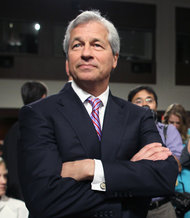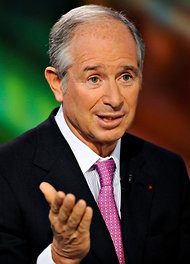 Mark Wilson/Getty ImagesJamie Dimon, the chief executive of JPMorgan Chase.
Mark Wilson/Getty ImagesJamie Dimon, the chief executive of JPMorgan Chase.
Even as two of the nation’s largest banks reported record profits on Friday, beneath the rosy earnings were signs that a sharp uptick in interest rates could spell trouble ahead for Wall Street and the broader housing market.
Kicking off bank earnings season, JPMorgan Chase and Wells Fargo handily beat analysts’ expectations. Profit at JPMorgan surged 31 percent, bolstered by gains in the bank’s trading and investment banking business. Wells Fargo, the biggest home lender in the country, posted a 19 percent increase in its second-quarter profit.
The gains were spread across the banks except for one important source: mortgage banking. The results showed that refinancing activity slowed, as did demand for mortgage loans.
The results could worsen. If rates continue to rise, fewer borrowers are likely to refinance or buy a house. And if the mortgage bond market weakens, banks will take a smaller gain when selling the mortgages.
Related Links
- JPMorgan Faces Questions on Potential New Capital Rules
 Video: Wall Street Feigns Modesty
Video: Wall Street Feigns Modesty Document: JPMorgan Chase release (PDF)
Document: JPMorgan Chase release (PDF)- Wells Fargo Profit Jumps 19 Percent
While these concerns have loomed for months, the earnings on Friday offered the clearest picture yet of how the interest rate turmoil could affect the banks, whose fortunes hinge in part on their lending businesses.
“We’re trying to be clear with you that this would be a significant event,” Marianne Lake, JPMorgan’s chief financial officer, said on Friday, referring to the potential effect of rising rates on the industry. She cautioned analysts that the volumes of mortgage refinancing could plunge by an “estimated 30 percent to 40 percent” in the second half of this year.
The results from JPMorgan and Wells are a barometer for the housing market because the two banks together account for the majority of all mortgages in the United States. In recent years, the recovery in the market has fueled the earnings of both companies and has also played a significant role in the broader economic rebound.
Until now, the banks have benefited from government policies intended to stimulate the economy in the wake of the financial crisis. As the Federal Reserve cut interest rates in recent years, for example, it spurred millions of borrowers to refinance their home loans to take advantage of the lower costs.
But the Fed has signaled in recent weeks that it could ease its stimulus as the economy continues to recover. The warning has prompted investors to drive up interest rates around the globe. Since Fed officials first hinted that they might retreat, the rate for a 30-year fixed mortgage has risen to 4.78 percent from a low of 3.54 percent.
The banks’ second-quarter results show the early results of the sudden surge. In the second quarter, Wells Fargo received $146 billion worth of quarterly home loan applications, down from $208 billion in the period a year earlier. Its mortgage originations totaled $112 billion, down from $131 billion.
At JPMorgan, mortgage originations rose 12 percent in the quarter, to $49 billion, but overall profit in mortgage banking fell by 14 percent, to $1.1 billion.
On Friday, JPMorgan executives said the slowdown could be even more extreme than previous forecasts have suggested. While both banks might be able to seize on the uptick in interest rates to create a bigger spread between the income they derive from lending and the ultimate cost of borrowing, those benefits proved elusive.
Net interest margin, a critical measure that reveals how much profit banks earn on their loans, fell at JPMorgan, settling in at 2.60 percent for the quarter, from 2.83 percent in the previous quarter. At Wells Fargo, it was 3.46 percent, down from 3.48 percent in the first quarter.
The results suggested that the surge in interest rates came too late in the second quarter to significantly affect the banks, but that the increase could cause deeper problems in the second half of the year.
Christopher Whalen, an investor and housing market analyst at Carrington Investment Services, said that the numbers that Wells and JPMorgan presented were a “very big deal.”
“Everybody in the mortgage industry is going to have to reassess their view of this year and next,” Mr. Whalen said.
Rising rates, though, might help other parts of the banks’ business. Within its fixed-income trading operations, for example, JPMorgan reported an 18 percent increase in revenue. Fees in JPMorgan’s investment banking unit surged 38 percent, to $1.7 billion.
Wells Fargo executives played down the significance of the rate change, noting that mortgage rates were still extremely low by historical standards. John Stumpf, the bank’s chief executive, pointed to the interest he paid for his own mortgages.
“If you were in the mortgage market before 2000, you know that these are unbelievably good rates,” Mr. Stumpf said. “My first mortgage was at 8.5 percent. My second one was at 11.5 percent, and I thought those were great rates at those times.”
Mr. Stumpf noted that the uptick in rates stemmed from the Fed’s indication that the economy was improving. Housing prices are rising and demand for homes has soared.
As the improvements continue, he said, a growth in loans for new home purchases will more than make up for any losses in refinancing.
“I’ll take that trade all day,” Mr. Stumpf said. “It’s good for America, it’s good for the economy and in the long term, it’s good for our business.”
Wells’s overall loan portfolio, which includes commercial and consumer lending, actually rose 3 percent to $802 billion in the second quarter. A bump in credit cards and commercial lending — and record origination of auto loans — further offset the home loan slowdown. The bank’s total average deposits reached $1 trillion, up 9 percent from a year ago.
But important drivers of the returns at Wells Fargo and JPMorgan did not stem from substantial growth in the underlying businesses. Instead, they came from reduced expenses.
Wells Fargo, for example, reduced a crucial expense — building a reserve for bad loans. This move reflected improvements in the quality of loans.
In the second quarter, JPMorgan also lifted its profits by reducing loan-loss reserves by $1.5 billion. The bank defended the practice, saying it pointed to the improving condition of its loans.
Yet Jamie Dimon, JPMorgan’s chief executive, conceded that fresh loan growth was still “soft.”
Nathaniel Popper contributed reporting.
Article source: http://dealbook.nytimes.com/2013/07/12/jpmorgan-quarterly-earnings-surge-31-percent/?partner=rss&emc=rss


